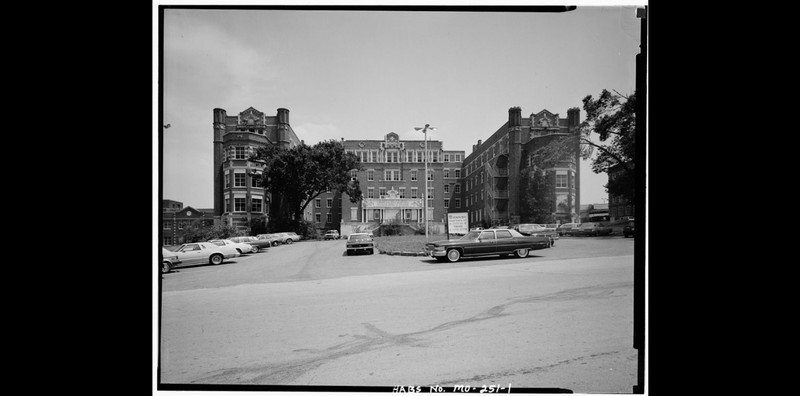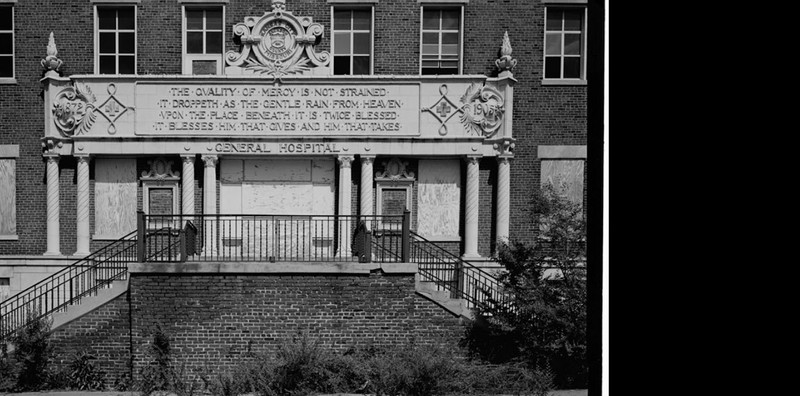General Hospital (1908-1976)
Introduction
Text-to-speech Audio
General Hospital was completed in 1908 to accommodate Kansas City's growth and the increased reliance by the public on hospitals for medical care. As more people relied on hospitals for medical care, local citizens began an effort to secure public funding for a new hospital and voters approved a bond issue of $225,000 in 1903. Two years later, Colonel Thomas Swope donated 4.5 acres of land atop a hill between Gillham and current-day Kenwood. While constructing the architects realized that the original cost estimates fell short for the hospital to meet the needs of the city. They doubled the beds which doubled the cost. Swope's donation of this land for medical care led to more facilities being constructed in the area and soon the area was known as "Hospital Hill." With newer and larger hospitals being constructed throughout the city, Hospital Hill became home to additional facilities, including Truman Medical Center in 1976, the same year General Hospital served its last patients. The former hospital was demolished in the early 1990s despite efforts by preservationists who hoped at least part of the historic hospital could be repurposed to fit the needs of the city once again.
Images
General Hospital

Detail of the façade of the former hospital

Backstory and Context
Text-to-speech Audio
General Hospital was designed by local architects Roots & Siemens and Frederick C. Gunn, who decided on a five-story structure featuring a neo-Jacobean design, an early English Renaissance style of architecture. The building opened in 1908 and drew acclaim for its modern facilities, as well as its free-form use of columns, flat roofs, and low walls around balconies and roofs. The building's architecture also borrowed from Elizabethan designs and included scrollwork, strapwork, and lozenges. The architects wanted a clean, yet cheerful comfortable appearance that would be constructed with durable materials but required little maintenance, so they chose a gray vitrified brick that was inexpensive yet attractive and non-absorbent. For the ornamentation, white crystallized limestone was used along with semi-glazed white terracotta that was added to give a bright and cheerful addition.
General Hospital consisted of three separate buildings that were connected by hallways. The “administrative wing” was where emergency, surgical, and outpatient services were located. The basement housed the drug store, ambulance entrance, receiving and examination room, emergency operating room, consultation rooms, and waiting rooms. The first floor housed the lab and X-ray rooms and record rooms. Patient wards were located on the second and third floor, while the fourth floor was home to various surgical rooms, including two operating amphitheaters and the library and quarters for nurses and interns. The hospital also included a service wing that housed laundry, kitchens, dining rooms, and the morgue. This wing also held small wards, a main operating room, an assembly room, a post-mortem room, and a “pathological museum”.
The wards featured some new innovations in design that demonstrate the growing emphasis on functionality in hospital design. for example, the rooms had rounded corners to provide easier access for gurneys and wheeled beds. The reduction of hard corners also supported modern cleaning protocols that reflected a growing awareness and emphasis on sanitation, while the hardwood floors with marble window sills demonstrated the attention to detail Kansas Citians hoped to see in all aspects of hospital operations. The wards housed specific operations for newborns, another section for children with contagious diseases, and a ward for those with mental illness as well as separate spaces for the care of prisoners or acute alcoholics. The hospital had electric elevators, an ice plant, an electric light plant, and a private switchboard.
By the 1920s, the hospital was regularly housing more patients than called for in the original design as the city grew and as more people relied on hospitals for medical care. In response, hospital directors built a new outpatient facility to handle the increased patient load. In 1927, the city added an annex to the 1911 isolation structure and made it the home for tuberculosis patients and male chronic patients.
Numerous changes occurred during the 1930s, including the name change to General Hospital No.1 which was newly constructed, and the original building was moved into the hands of the Black community. This took a lot of effort from the Black community leaders, and so they got General Hospital No.2 , its purpose was to serve the African American population in an age where schools, hospitals, parks, and other public facilities were segregated.[4] In 1931 the southwest residence halls were converted into ward space to accommodate 100 more beds. In 1936 a three-story receiving ward was constructed and connected to the isolation building. Even with these and many other renovations and additions, by the mid-1930s, General Hospital regularly struggled to meet demands and by 1937, the hospital was averaging about 400 patients a day.
The pattern of renovation and addition continued in the 1940s. In 1957, General Hospital 1 and General Hospital 2 were consolidated in an effort to save money and achieve at least partial integration, but only the former goal was achieved. Budget cuts were made in 1968 which forced the hospital to turn away many patients. During this same era, the growth of the city's medical sector saw more facilities near General Hospital such as UMKC Medical School, the relocation of Children’s Mercy Hospital, and the construction of Truman Medical Center, forming a large health care complex on Hospital Hill.
With Truman Medical Center opening in 1976, General Hospital served its final patients. For some, the aging building stood in the way of expansion while others hoped the building could be repurposed. Deciding that the cost of restoring the aging building made such a project less desirable than supporting new construction, demolition of the city's former leading hospital began in the spring of 1991. All but the north wing was demolished at that time, allowing for a last-ditch effort to save and renovate that part of the historic building. This effort proved unsuccessful, and the north wing was demolished in 1992.
Cite This Entry
Admin, Clio and Sylvia Jeffress. "General Hospital (1908-1976)." Clio: Your Guide to History. November 10, 2021. Accessed March 19, 2025. https://theclio.com/entry/141148
Sources
[1]Lee, Janice. General Hospital, The Kansas City Library. Accessed November 9th 2021. https://www.pendergastkc.org/article/buildings-orgs/general-hospital.
[2] Lee, Janice. General Hospital Profile, Missouri Valley Special Collections. 1999. Accessed November 6th 2021. https://kchistory.org/document/general-hospital-profile?solr_nav%5Bid%5D=3f6483d25f714f31d470&solr_nav%5Bpage%5D=0&solr_nav%5Boffset%5D=0&search=General%2520hospital.
[3] CENTER SECTION, WEST SIDE. DETAIL ENTRANCE. VIEW LOOKING EAST - Kansas City General Hospital, 2315 Locust, Kansas City, Jackson County, MO Photos from Survey HABS MO-251 , Library Of Congress. Accessed November 6th 2021. https://www.loc.gov/resource/hhh.mo0513.photos/?sp=3.
[4] Robertson, Joe. "Neglected History Sought." The Kansas City Star (Kansas City) March 10th 2013. , A4-A4.
https://www.loc.gov/item/mo0513/
https://www.loc.gov/item/mo0513/

